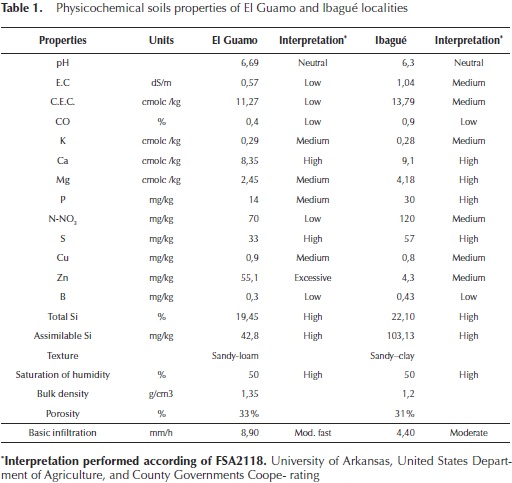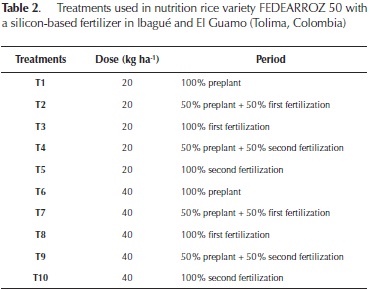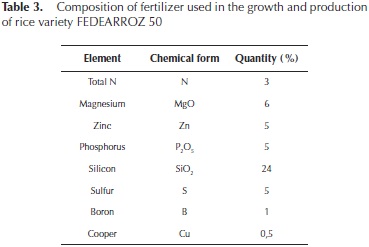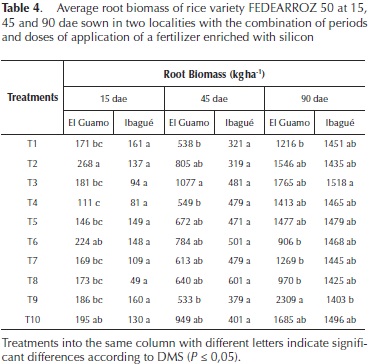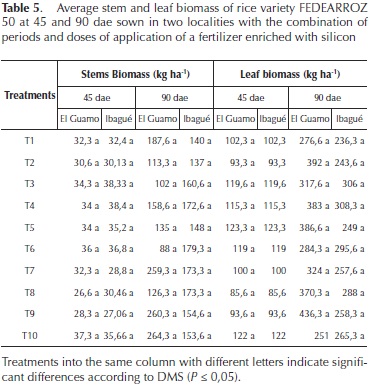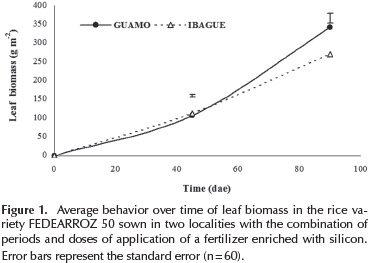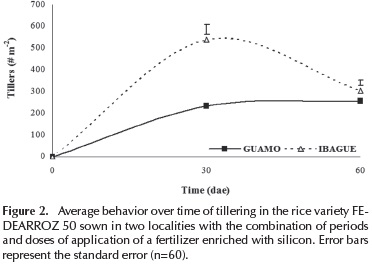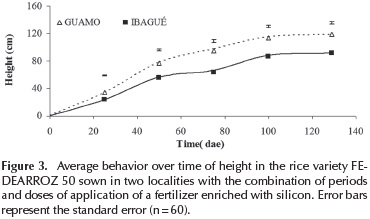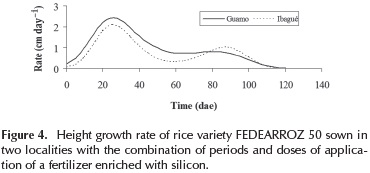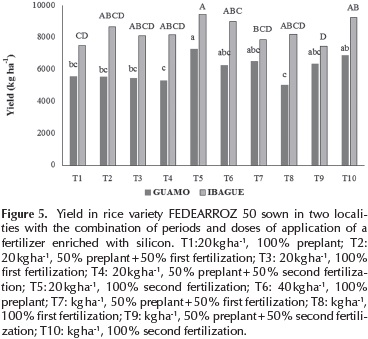Services on Demand
Journal
Article
Indicators
-
 Cited by SciELO
Cited by SciELO -
 Access statistics
Access statistics
Related links
-
 Cited by Google
Cited by Google -
 Similars in
SciELO
Similars in
SciELO -
 Similars in Google
Similars in Google
Share
Ingeniería e Investigación
Print version ISSN 0120-5609
Ing. Investig. vol.37 no.1 Bogotá Jan./Apr. 2017
https://doi.org/10.15446/ing.investig.v37n1.59344
DOI: http://dx.doi.org/10.15446/ing.investig.v37n1.59344
Growth and production of rice (Oryza Sativa L.) under different fertilization plans with silicon
Crecimiento y producción de arroz (Oryza sativa L.) bajo diferentes planes de fertilización con silicio
Javier Giovanni Álvarez-Herrera1, Lida Paola Pinzón-Gómez2, and Javier Enrique Vélez3
1 Agricultural Engineer, MSc. Ph.D. Universidad Nacional de Colombia. Affiliation: Assistance Professor, Universidad Pedagógica y Tecnológica de Colombia, Tunja, Agriculture Research Group, GIA, Colombia. E-mail: jgalvarezh@gmail.com
2 Agricultural Engineer, Universidad Pedagógica y Tecnológica de Colombia. Agriculture Research Group, GIA, Tunja, Colombia. E-mail: lpaopg9@gmail.com
3 Agricultural Engineer, MSc. Universidad Nacional de Colombia. Ph.D. Universidad Politécnica de Valencia. Affiliation: Civil and Agricultural Engineering Department of Universidad Nacional de Colombia. Bogotá, Colombia. E-mail: jevelezs@unal.edu.co
How to cite: Álvarez-Herrera J.G., Pinzón-Gómez L. P., and Vélez J.E. (2017). Growth and Production of rice (Oryza Sativa l.) under different fertilization plans with Silicon. Ingeniería e Investigación, 37(1), 7-15. DOI: 10.15446/ing.investig.v37n1.59344.
Received: July 29th 2016 Accepted: February 27th 2017.
ABSTRACT
The application of fertilizers to rice crops constitutes a large percentage of productions costs, which in recent years have increased; therefore, it is necessary to implement alternatives that optimize the application and improve profitability. It was evaluated the effect of different doses and application times of a fertilizer with silicon on a rice crop, Fedearroz 50 variety. The experimental design was completely randomized with a 2 x 5 factorial arrangement. The first factor was dose (20 and 40 kg ha-1) and the second factor was combination of period and application dose (100 % preplant, 50 % preplant + 50 % first fertilization, 100 % first fertilization, 50 % preplant +50 % second fertilization, 100 % second fertilization) for a total of 10 treatments that were applied in 2 locations (Ibagué and El Guamo). We found that the preplant fertilizer applications increased the production of root biomass throughout the crop cycle and that the biomass of the stems and leaves had a similar behavior with the two doses of silicon. The tillering in Ibagué presented a value of 520 clusters m-2, 127 % higher than in El Guamo, which had a value of 229 clusters m-2, a highly significant difference. Throughout the period, height showed a behavior model double logistic sigmoid; the height of the rice plants was higher in El Guamo. In the two localities, Ibagué and El Guamo, the most appropriate fertilizer dose of silicon was 20 kg ha-1 in the second fertilization.
Keywords: Fertilizer, physiology, tillering, plant height, double logistic sigmoid.
RESUMEN
La aplicación de fertilizantes en el cultivo de arroz ocupa un gran porcentaje de los costos de producción, los cuales en los últimos años han incrementado, por lo tanto, se hace necesario implementar alternativas que optimicen la aplicación y mejoren la rentabilidad. Se evaluó el efecto de diferentes dosis y épocas de un fertilizante con silicio en el cultivo de arroz, variedad Fedearroz 50. El diseño experimental fue completamente al azar con factorial de 2 x 5. El primer factor fue la dosis (20 y 40 kg ha-1), y el segundo factor la combinación de época y dosis de aplicación (100 % presiembra, 50 % presiembra + 50 % 1a abonada, 100 % a la 1a abonada, 50 % presiembra + 50 % 2a abonada, 100 % a la 2a abonada) para un total de 10 tratamientos, aplicados en 2 localidades (Ibagué y El Guamo). Se encontró que las aplicaciones del fertilizante en presiembra generaron una mayor producción de biomasa radical a lo largo del ciclo de cultivo; la biomasa de tallos y hojas tuvo un comportamiento similar con las dos dosis aplicadas de silicio. El macollamiento en Ibagué presentó un valor de 520 macollas/m2, un 127 % más que en El Guamo, que tuvo un valor de 229 macollas/m2, por lo que las diferencias entre localidades son altamente significativas. A lo largo del tiempo la altura presentó un comportamiento de modelo logístico doble sigmoideo, en donde la altura de las plantas de arroz fue mayor en la localidad de El Guamo. En las dos localidades, la dosis de silicio que generó mayor crecimiento y producción fue la de 20 kg ha-1 aplicada el 100 % en segunda abonada.
Palabras clave: Fertilizante, fisiología, macollamiento, altura de planta, logístico doble sigmoide.
Introduction
In rice cultivation, fertilizers represent about 19 % of production costs; however, proper fertilization management helps increase performance and could reduce production costs (Reza, Corteza, Hamidreza, Salman and Alireza, 2012). Fertilizer doses have increased over time in order to achieve better yields, which increase the economic cost of obtaining high productions; therefore, there is a need to test new sources of nutrients based on mixtures of organic fertilizers and chemical materials that could decrease production costs and increase crop yields (Álvarez-Herrera, Daza-Torres and Mendoza, 2008).
Similarly, it has been proven that an application of OM and chemical fertilizers increases the production of rice, particularly when silicon (Si) is applied, an element that is considered beneficial and, although it does not meet the criteria of essentiality, stimulates the growth and productivity of some species (Castilla and Flores, 2014). Silicon accumulates in the cell walls of Gramineae, such as rice and sugar cane, and decreases plant stress (Chen, Yao, Cai and Chen, 2011), so that a rice crop absorbs between 1000 and 1200 kg ha-1 of silicon oxide from the soil, which is accumulated in the spigot and rice grains (Meena et al., 2014).
Silicon is attributed with many beneficial effects for the cultivation of rice, as it increases the tolerance of plants to the abiotic stress caused by drought and biotic stress and reduces the incidence of diseases such as Pyricularia (Mauad, Costa, Cruscial, Grassi-Filho and Corrêa, 2013), because this nutrient reinforces the cell wall (Epstein, 1999) and, thereby, increases the mass and grain production (Detmann et al., 2012), also it helps to maintain high amounts of dry biomass (Tamai and Ma, 2008).
In this regard, Epstein (1999) stated that, of the 147 plants observed, rice showed the highest amounts of Si in the leaves, with a value of 6,3 % of total dry matter. Bejarano and Ordóñez (1999) found that the highest dose of potassium silicate (400 kg ha-1) presented a higher crop yield (6527 kg ha-1); likewise, Mauad et al. (2003a) found that combinations of 5 kg ha-1 of N and 600 kg ha-1 of Si increased levels of foliar Si, whereas, with 5 kg ha-1 of N and no application of Si, the silicon content in the plants was the lowest. However, Mauad et al. (2011) found that there was no dose effect from silicon on the accumulation of dry matter and noted that there are reports in the literature about the effects of silicon in pests and diseases control; nevertheless, little is known about the effect of this element on the processes of cell growth and division.
Therefore, the aim of this study was to determine the effect of the application of Silicon on the growth and production of rice plants, seeking to increase the efficiency of crop production.
Materials and Methods
Location: The research was conducted under field conditions at two localities in Tolima (Colombia): location 1, the "Rancho Alegre" farm in the village of Las Mercedes, municipality of El Guamo located at 4° 11'22'' N and 75° 1' 7'' W and 399 m a.s.l., average temperature of 28 °C, relative humidity of 72 % and annual rainfall of 1288 mm year; location 2, the "Cauchitos" farm in the municipality of Ibagué with the geographic coordinates 4°23'51'' N, 75°9' 7'' W and 979 ma.s.l., average temperature of 24,3°C, relative humidity of 64 %-86 % and annual rainfall of 1450 mm year.
Soil description: The two locations had an ochric epipedon that was characterized by a light color when dry and a usually grayish brown and darker color when moistened; the organic matter content was low; generally, the organic Carbon was <0,4% and the iron content were low. The endopedon in the El Guamo location was Cambic; this horizon was characterized by a low content of organic matter, with a more or less developed structure and a lack of rock in at least half of its volume, with a sandy loam or fine texture (content clay <8 %). The endopedon in the Ibagué location is argillic horizon that is located at 40 cm in depth; it has an accumulation of clay caused by processes of translocation of fine materials through the Ap horizon. Moreover, the result of the chemical analysis of the soil for the two locations is presented in Table 1.
Ecotype: The rice variety used was FEDEARROZ 50, which has a vegetative period of 115 to 130 days and an intermediate tillering in traditional planting systems with stems that exhibit high resistance to overturning. Its empty hulls range from 12 % to 25 %. It is resistant to a large number of pests and diseases. It is not tolerant to permanent flooding. It responds well to the fertilization doses and periods of each zone. Between 180 and 250 kg ha-1 of seed should be used, depending on soil type.
Experiment Design: For the two locations, a completely randomized design with a factorial arrangement of 2 x 5 was used. The first factor corresponded to the dose of the applied fertilizer (20 and 40 kg ha-1) and the second factor was the combination of the fertilizer proportion and the period of application for a total of 10 treatments with three replicates (Table 2), corresponding to 30 experimental units (EU) per location. Each experimental unit (EU) had an area of 30 m2, for a total studied area of 900 m2 per location.
Planting and Fertilizer: In El Guamo, the planting was done with a SEMEATO sowing machine, using a density of 180 kg ha-1 of seed. The soil preparation was done with four passes with a harrow, one with a rake and one to make level areas and ridges with a height of 0,5 m and a width of 1,2 m. At 20 days after emergence (dae) and after the Butaclor herbicide application, the crop had a slight delay because of low rainfall for almost 20 days. In Ibagué, broadcast seeding was carried out with a density of 200 kg ha-1 of seed. The soil preparation was done with two passes with a harrow and one with a rake and then the ridges were made.
The fertilizer used in the experiment was a supplement fertilizer mainly composed of silicon and O.M., formed by phosphoric rock, magnesium silicate, zinc and copper sulfate for the mineral content, and legumes, grasses and horse manure for the organic matter. This physical mixture of the above sources was done by first crushing and then and the respective concentration was determined in a using solidification. The application was done manually laboratory, as shown in Table 3.
Doses of 20 and 40 kg ha-1 were used because, traditionally, applying a fertilizer supplement that contains Si and minor elements to more than 40 kg ha-1 is uneconomical. The application periods were chosen according to normal fertilization plans in the area: preplant, first fertilization (when tillering starts 20-25 days after emergence (dae)), and second fertilization (initiation of floral primordium 5-55 dae).
In El Guamo, compound based fertilizer was used; it was scheduled as follows: preplant, 50 kg ha-1 of DAP and 20 kg ha-1 of Zinc Sulfate; first fertilization, 50 kg ha-1 of urea, 50 kg ha-1 of ammonium sulfate (SAM), 25 kg ha-1 of KCl, 25 kg ha-1 of DAP and 20 kg ha-1 of zinc sulfate; second fertilization, 75 kg ha-1 of urea, 75 kg ha-1 of SAM, 50 kg ha-1 of KCl; and third fertilization, 75 kg ha-1 of urea, 50 kg ha-1 of SAM, 25 kg ha-1 of KCl. The fertilization base used in Ibagué was 200 kg ha-1 of urea, 50 kg ha-1 of DAP and 90 kg ha-1 of KCl, divided equally between the 4 fertilization periods.
Response variables: The evaluated variables were root biomass (kg ha-1), which was determined at 15, 45 and 90 dae. The samples were taken from a strip of 0,25 m by 0,25 m for each UE. Similarly, the stem biomass (g cm-2) and the leaf biomass (g cm-2) were determined at 45 and 90 dae, and the tillering (# of tillers m-2) was realized at 30 and 60 dae for the two locations. It was determined the number of tillers by counting those found in a randomly thrown 0,25 x 0,25 m sampling square.
Finally, the plant height (cm) was determined based on the average of 5 plants per EU at 25, 50, 75, 100 dae, and at harvest (129 dae in Ibagué and 133 dae in El Guamo), using the distance from the stem base to the tip of the flag leaf as a reference. A double sigmoid logistic model was used, which is one of the growth models that best fit biological variables such as fruit diameter, plant height, and stem diameter, among others (Lipovetsky, 2010). This model uses the following equation:
where f (t) is plant height in cm according to time; α is the maximum value of the variable in time in cm; and b, c, d and e are constants related to the relative speeds and inflection points of the growth curve.
Data Analysis: a normality test was performed and atypical or erroneous data were removed; then, a homogeneity test of variance was conducted (Bartlett test) for each measured variable to see whether the results obtained in the two locations could be analyzed together. In each case, an analysis of variance (Anova) was done for each of the measured variables at 5 % and not only were the separate effects of location, dose and period taken into account, but the interactions were also (i.e., dose*location, dose*period, location*period and dose *period*location). Next, the differences were compared using the method of least significant differences, LSD (P≤0,05), and the correlation between the different variables was analyzed using the statistical package SAS v. 8e.
Results and Discussion
Root Biomass: The Bartlett homogeneity test showed that, for the root biomass variable at 15 dae, the variances were homogeneous, so the Anova was analyzed jointly for the two locations, which showed significant differences for the interaction of period and dose and the LSD determined differences between the locations.
The root biomass at 15 dae showed differences in the El Guamo when the fertilizer was applied by varying the doses and periods simultaneously (Table 4); this difference may have occurred because some of the plants did not receive the fertilization at 15 dae according to the treatments and this caused that some treatments had a higher nutritional value and a consequent increased root biomass. According to Riveros and Rodríguez (2010), the development of the root system of rice plants depends on several factors, such as soil aeration, proper weed control and proper application of the fertilizer.
The El Guamo location, at 15 dae, presented a production of root biomass of 176,1kg ha-1 versus 116,7 kg ha-1 in Ibagué, a 50 % increase; this difference was subject to the interaction of the period and fertilizer dose and could have been caused by the pore space as a clay horizon was found in the El Guamo location, which reduced the O2 content and increased the accumulation of CO2 in the micro and macropores of the soil, reducing the growth of the roots (Castilla, 2012).
The treatments with the highest values of root biomass at 15 dae were the application of 20 kg ha-1, 50 % preplant + 50 % first fertilization and 40 kg ha-1 with 100 % at preplant which were significantly better than the other treatments; possibly because they were the treatments with a higher fertilizer dose than others and because the other treatments, did not receive a fertilizer application for these dates (Table 4). Ma and Yamaji (2006) mentioned that rice is a typical Si-accumulating plant because Si can make up to 10 % of the shoot dry weight, which is several-fold higher than those of essential macronutrients such as N, P and K, moreover high levels of Si in rice tissues are attributed to the superior ability of the roots to take up this element.
For the variable of root biomass measured at 45 dae, the Anova was done jointly in the two locations, even so, there were no significant differences between the treatments; but there were significant differences between the averages of the locations. This means that the effect of the treatments in the two locations was the same, but the averages varied due to different conditions of the experiment, such as different soil types, temperatures, and radiation, among others. The El Guamo location presented 44 % more root biomass at 45 dae than Ibagué; this difference was due to the soil conditions mentioned above.
The radical system at 90 dae showed highly significant differences between the locations for both averages and variances. In the evaluation per location, the fertilizer application had no effect on the root system at 90 DAE in El Guamo; this could have been due to the fact that the soil porous space was plentiful and there was no limitation for radical growth; while in Ibagué, the period of application significantly influenced the production of root biomass when comparing only the treatments with the fertilizer application. In Ibagué, the best treatment was the application of 20 kg ha- 1, 100 % first fertilization (Table 4); also, the first fertilization had significant differences with the treatments that had an application in the second fertilization.
By analyzing the variation of the root system for the two locations and treatments over time, it was observed that, in the El Guamo location, there was a higher production of root biomass than in the Ibagué location for all treatments; this might have been caused by the argillic horizon in Ibagué, which resulted in less absorption of nutrients by the roots, reducing root growth.
Stems Biomass: The Bartlett homogeneity test for the stem biomass at 45 and 90 dae determined that the Anova could be analyzed for the two locations together; however, it did not determine significant differences in the biomass of the stems at 45 or 90 dae for any of the combinations of doses, periods or locations, indicated that the stems at both locations did not respond to the different fertilizer application treatments that were enriched with silicon. Mauad et al. (2011) did not find any effects from different doses of silicon on the accumulation of dry matter in rice plants. Overall, in Ibagué, all of the treatments had higher values t han those of the El Guamo location, which was consistent with the soil analysis, which showed a higher number of bases (Ca, Mg, K) here than in the Ibagué location (Table 5).
The stem biomass at 90 dae showed highly significant differences between the two locations and had a higher response in Ibagué with 159,8 g m-2, while in El Guamo; it was 137,9 g m-2, 15 % more. This significant difference resulted from the natural conditions of each of the areas.
Over time, the difference between the locations increased and there were no significant differences between treatments for stem biomass; a comparison was made between the locations for the behavior of this variable based on the average and it was observed that the difference in stem biomass began to increase at 45 dae and presented a higher accumulation in Ibagué at 90 dae than in El Guamo, which could have been caused by the higher content of nutrients in the soil, which causes the stem and the leaves temporarily store photoassimilates that will become part of the reproductive organs, especially the grains.
Leaf biomass: The homogeneity test for the leaf biomass at 45 dae determined that the analysis of variance could be realized jointly for the two locations; this was not significantly different between the treatments. However, the Ibagué location had an average value of 113 g m-2, as compared to 107 g m-2 in the El Guamo location, 5 % more, which, according to the LSD method for the locations, was not significant.
For leaf biomass at 90 dae, Bartlett's test indicated that the Anova had to be done separately for each location; even so, there was no significant difference between the fertilizer doses; however, the El Guamo location presented a value of 342 g m-2 and the Ibagué location presented 270 g m-2, 26 % more, a significant difference (Figure 1). These results are consistent with previous results; Tokura, Furtini, Curi, Carneiro and Abuisi (2007) did not find alterations in biomass production of rice plants after applications of Si, inferring that the lack of response in rice productivity with increased fertilization with Si could have been due to the sum of several factors, including the low concentration of Si in the soil available to plants, even after application of this element.
This indicates that the fertilizer did not have an effect on the production of biomass in the leaves at 45 or at 90 dae and correlates with the production variable of stem biomass, which was not affected by the treatments because the Si would have had little effect on the vegetative stage of rice seedlings (Mauad et al., 2003b).
The variation over time for the two locations for leaf biomass did not differ between the treatments. It was observed that, in the Ibagué location, the translocation of photoassimilates to the spikelets occurred sooner than in the El Guamo location, thus reducing leaf biomass. This reduction resulted because, in Ibagué, there was more radiation, which generated acceleration in the rate of photosynthesis and in the production and translocation of carbohydrates (Deng et al., 2015). In general, the dry matter of both stems and leaves presented a similar behavior, where, in the early days, there was slow growth and, after tillering began, there was an increase in the growth rate until the flowering stage (90 dae), in which the dry biomass filled the spikelets almost 50 % faster in El Guamo than in Ibagué.
Tillering: The Bartlett test of homogeneity indicated that the analysis of variance by location for tillering at 30 dae should be done separately; however, there was no significant difference between the treatments for the two locations. In spite of, Castilla (2011), when making applications of soluble Si at doses of 1,0 and 2,0 L ha-1 between sowing and tillering, achieved a higher tillering and yield than the control treatment, with a high number of grains per panicle.
The Ibagué location presented a value of 520 plants m-2, 127 % more than the value of 229 plants m-2 seen in El Guamo, resulting in highly significant differences between the locations. These differences may have been caused by the initial level of N in the soil (Table 1), because according to Sasaki, Ando and Kakuda (2002), a better availability of N in the soil correlates with a high number of tillers, and the results of nitrogen in the soil analysis showed that there was a higher value in Ibagué. About, Sharief, El-Kalla, El-Kassaby, Ghonema and Abdo (2006) after increasing nitrogen levels achieved an increase of tillers m-2 by more than 22 %. Similarly, several studies have shown that applications of N in rice lead to an increase in plant height, number of panicles, leaf size, number of spikelets and grain yield (Kamara, Ekeleme, Omaigui and Chikoye, 2011).
Moreover, the planting method has significant influence on tillering since broadcast seeding systems will always have more tillers than mechanized planting or planting by row, because, when broadcasting, the seed is not fully covered and generates more tillers than when seeders are used because they bury the seed at some depth, decreasing the percentage of seed germination.
Another cause of the difference in tillering between the locations could have been caused by the height of water level because, in El Guamo, the ridge height was 40 cm while the height in Ibagué was 20 cm, and, according to Monasterio, Lugo, Álvarez and López,(2012), rice plants, when subjected to low levels of water, increase their potential for tiller production.
The tillering at 60 dae was analyzed separately for each location; however, the Anova did not show a significance difference between the applied treatments for the two locations. The Ibagué location presented a value of 321plants m-2, while the El Guamo location presented a value of 243 plants m-2, 32 % more, a significant difference.
The tillering in the two locations did not differ among the treatments; even so, this varies with the time. In the Ibagué location, it was observed that the number of tillers achieved its maximum value at 30 dae and, then, decreased significantly by 40 % at 60 dae (Figure 2). This decrease was due to the seeding system used (seed broadcasting) and the number of plants per site that this system sees, thus causing competition for sunlight and nutrients, especially nitrogen, favoring the growth of stronger tillers. Similarly, Riveros and Rodríguez (2010) stated that any condition that limits the rate of photosynthesis also limits the development of tillers. Meanwhile, in El Guamo, there was a significant increase of 6 % in the number of tillers, which could have been caused by the water stress that presented in this area, which could increase the action related to N metabolism enzymes in stimulating plant tillering.
Plant Height: The measurements at 25 and 50 dae for height were analyzed separately due to the difference in the variances, while the heights at 75, 100 and 129 dae (or harvest) were analyzed jointly for the two locations; this may mean that initially varying heights depended on the fertility and the environmental conditions of each of the soils.
The plant heights at 25 and 50 dae showed no significant differences between the treatments for the two locations; however, between the locations, there were significant differences among the averages of this variable, with the El Guamo location having 43 % and 38 % higher heights at 25 and 50 dae (Figure 3), respectively, than in the Ibagué location. Klotzbücher et al. (2014) stated that the specific properties of the soil and climate in different regions make plants have a different response to Si applications.
Jointly analyzing the heights at 75, 100 and harvest for the locations of El Guamo and Ibagué (129 dae and 133 dae, respectively) showed no difference among these treatments, but there were significant differences between the locations, where El Guamo grew heights that were 46 %, 43 % and 32 % higher at these respective times than in Ibagué. The height behavior of the rice plants over time showed significant differences between the treatments, which mean that, over time, the variable of height behaved differently for each of the applied treatments (Figure 3).
Differences were also observed in plant height during the rice harvest cycle between the two locations; this might have been because the El Guamo ridge height was 40 cm, forming a high water surface height, while the height of the ridge in Ibagué was 20 cm, favoring excessive stem elongation and leaf sheaths (Monasterio et al., 2012).
The equation that best related height over time for the two locations was the double sigmoid logistic model type, which was elevated to a polynomial of degree 3 due to the inflected rice plant growth during the production cycle caused by the different growth stages. This is presented below:
Upon analyzing the growth rate in height, by means of the derívate of equations found, which are reflected in Figure 4, it was observed that right in the middle of the stages of tillering (26 dae for both localities) and panicle initiation (81 dae in El Guamo and 88 dae in Ibagué), the highest rate of growth occurred; the opposite of what happened in the stages of panicle booting, ripening and senescence, where the plant height decreased its growth rate. From the previous model, it can define that fertilization for filling panicle can be performed from 81 days to El El Guamo and 88 days for the area of Ibagué.
Paddy rice production: The application of the treatments resulted in significant differences in the two locations. When 40 kg ha-1 of fertilizer were applied in second fertilization showed increased paddy rice production in Ibagué with 8,5 t ha-1, whereas for El Guamo, application of 20 kg ha-1 in first fertilization had the highest values with 6,1 t ha-1 (Figure 5).
In addition to increases in production that generates silicon fertilization in the cultivation of rice, other advantages of the application of this element is that it helps mitigate the effect of biotic stress (blast, sheath blight, brown spot, planthopper, stem borer and leaf folder) and abiotic (salinity, lodging, high light intensity, drought, toxic metal), and also it increases the nutritional quality of rice (Meharg and Meharg, 2015).
Localities have significant differences with regard to production, since averaging all treatments in Ibagué production was 8,2 t ha-1, while the El Guamo was 5,8 t ha-1, a situation that occurs due to greater fertility potential in the area of Ibagué and better climatic and soil conditions for the development of rice cultivation (Castilla, 2012).
By linking production with growth variables measures, it was found that the production is inversely proportional to plant height at 25 dae, as well as the root system at 15 dae, which means that as the plant height and root system are higher, production was lower in the El Guamo. In Ibagué, the yield was directly proportional to the tillering (r2 = 0,29, P> 0,001), leaf biomass (r2 = 0,45, P> 0,001), and biomass of stems (r2 = 0,39; P > 0,001) at 60 dae, implying that a vigorous plant 60 dae rice will achieve to translocate a lot of photoassimilates to the rice spikelets.
Conclusions
In the two localities, Ibagué and El Guamo, the most appropriate fertilizer dose of silicon was 20 kg ha-1 in the second fertilization. In the El Guamo location, there was a higher production of root biomass than in the Ibagué location for all treatments. Applying silicon does not generate significant differences in fresh and dry root biomass, tillering and plant height. In the El Guamo location as the plant height and root system were higher, production was lower while in Ibagué the yield was directly proportional to the tillering, leaf biomass, and biomass of stems at 60 dae.
References
Álvarez-Herrera, J., Daza-Torres, M.C., and Mendoza, C. (2008). Aplicación de un fertilizante enriquecido con silicio y materia orgánica en Arroz (Oryza sativa L.) cultivado en Ibagué y el Guamo (Tolima, Colombia). Rev. Fac. Nal. Agr. Medellín. 61(2), 4605-4617. [ Links ]
Bejarano, M., and Ordóñez, R. (1999). Respuesta del cultivo de arroz a la aplicación de sílice en los Llanos orientales. Revista Arroz 48(419), 20-30. [ Links ]
Castilla, L.A. (2011). Estudio sobre la aplicación de silicio hidro-soluble en el cultivo de arroz. Revista Arroz 58(494), 32-45. [ Links ]
Castilla, L.A. (2012). Rendimientos de arroz en la Meseta de Ibagué (2007-201 1). Revista Arroz 60 (496), 4-10. [ Links ]
Castilla, L.A., and Flórez, E. (2014). SIFA: Sistema de fertilización en el cultivo de arroz a través de la web. Revista Arroz 62(509), 4-16. [ Links ]
Chen, W., Yao, X., Cai, K., and Chen. J. (2011). Silicon alleviates drought stress of rice plants by improving plant water status, photosynthesis and mineral nutrient absorption. Biological Trace Element 142(1) 67-76. DOI: 10.1007/s12011-010-8742-x [ Links ]
Deng, N., Ling, X., Sun, Y., Zhang, C., Fahad, S., Peng, S., Cui, K., Nie, L., and Huang, J. (2015). Influence of temperature and solar radiation on grain yield and quality in irrigated rice system. European Journal of Agronomy 64, 37-46. DOI: 10.1016/j.eja.2014.12.008. [ Links ]
Detmann, K., Araújo, W., Martins, S., Sanglard, L., Reis, J., Detmann, E., Rodriguez, F., Nunes-Nesi, A., Fernie, A., and DaMatta, F. (2012). Silicon nutrition increases grain yield, which, in turn, exerts a feed-forward stimulation of photosynthetic rates via enhanced mesophyll conductance and alters primary metabolism in rice. New Phytologyst 196, 752-762. DOI: 10.1111/j.1469-8137.2012.04299.x. [ Links ]
Epstein, E. (1999). Silicon. Annual Review of Plant Physiology and Plant Molecular Biology. 50, 641-649. DOI: 10.1146/annurev.arplant.50.1.641. [ Links ]
Kamara, A., Ekeleme, F., Omoigui, L.O., and Chikoye, D. (2011). Influence of nitrogen fertilization on yield and yield components of rain-fed lowland NERICA® rice in the northern Guinea savanna of Nigeria. African Journal of Agricultural Research, 6(13), 3092-3097. DOI: 10.5897/AJAR10.1058. [ Links ]
Klotzbücher, T., Marxen, A., Vetterlein, D., Schneiker, J., Türke, M., Van Sinh, N., Hung, N., Van Chien, H., Marquez, L., Villareal, S., Bustamante, J., and Jahn, R. (2014). Plant-available silicon in paddy soils as a key factor for sustainable rice production in Southeast Asia. Basic and Applied Ecology 16(8), 665-673. DOI: 10.1016/j.baae.2014.08.002. [ Links ]
Lipovetsky, S. (2010). Double logistic curve in regression modelling. Journal of Applied Statistics 37 (11), 1785-1793. DOI: 10.1080/02664760903093633. [ Links ]
Ma, J.F. and Yamaki, N. (2006). Silicon uptake and accumulation in higher plants. Trends in Plant Science 11(8), 392-397. DOI: 10.1016/j.tplants.2006.06.007. [ Links ]
Mauad, M., Grassi-Filho, H., Crusciol, C., and Corrêa, J. (2003a). Teores de Silício no solo e na planta de arroz de terras altas com diferentes doses de adubação silicatada e nitrogenada. Revista Brasilera de Ciencia do Solo 27, 867-873. DOI: 10.1590/S0100-06832003000500011. [ Links ]
Mauad, M., Costa, C., Grassi-Filho, H., and Corrêa, J. (2003b). Nitrogen and silicon fertilization of upland rice. Scientia Agricola, 60(4), 761-765. DOI: 10.1590/S0103-90162003000400023. [ Links ]
Mauad, M., Crusciol, C., and Grassi-Filho, H. (2011). Produção de massa seca e nutrição de cultivares de arroz de terras altas sob condição de déficit hídrico e adubação silicatada. Ciências Agrárias 32(3), 939-948. DOI: 10.5433/1679-0359.2011v32n3p939. [ Links ]
Mauad, M., Costa, C., Crusciol, C., Grassi-Filho, H., and Corrêa, J. (2013). Acúmulo de silício na parte aérea de cultivares de arroz de terras altas afetado pela aplicação de silicato e carbonato no solo. Ciências Agrárias 34(5), 2049-2060. DOI: 10.5433/1679-0359.2013v34n5p2049. [ Links ]
Meena, V.D., Dotaniya, M.L., Coumar, V., Rajendiran, S., Kundu, A., and Rao, S. (2014). A case for silicon fertilization to improve crop yields in tropical soils. Proc. Natl. Acad. ScI. 84(3), 505-518. DOI 10.1007/s40011-013-0270-y. [ Links ]
Meharg, C. and Meharg, A. (2015). Silicon, the silver bullet for mitigating biotic and abiotic stress, and improving grain quality, in rice. Enviromental and Experimental Botany 120, 8-17. DOI: 10.1016/j.envexpbot.2015.07.001. [ Links ]
Monasterio. P., Lugo, L., Álvarez, L., and López, H. (2012). Desarrollo y producción de arroz (Oryza sativa L.) con diferentes profundidades de láminas de agua en Calabozo, estado Guárico, Venezuela. Revista Científica UDO Agrícola. 12 (1), 117-126. [ Links ]
Reza, Y., Corteza, S., Hamidreza, M., Salman, D., and Alireza, N. (2012). Effect of plant density on morphologic characteristics related to lodging and yield components in different rice varieties (Oriza sativa L.). Journal of Agricultural Science 4(1), 31-38. DOI: 10.5539/jas.v4n1p31. [ Links ]
Riveros, G. and Rodríguez, N. Chapter 7: La Fisiología de la planta y la productividad del cultivo. 100-113 pp. In: De-giovanni, V., Martínez, C. and Motta, F. (2010). Producción eco-eficiente del Arroz en américa Latina. Tomo 1. CIAT. Cali, Colombia. 489 pp. [ Links ]
Sasaki, Y., Ando, H., and Kakuda, K. (2002). Relationship between ammonium nitrogen in soil solution and tiller number at early growth stage of rice. Soil Science and Plant nutrition 48(1), 57-93. DOI: 10.1080/00380768.2002.10409171. [ Links ]
Sharief, A., El-Kalla, S., El-Kassaby, A., Ghonema, M., and Abdo, G. (2006). Effect of bio-chemical fertilization and times of nutrient foliar application on grown, yield and yield components of rice. Journal of Agronomy 5(2), 212 -219. [ Links ]
Tamai, K. and Ma, J.F. (2008). Reexamination of silicon effects on rice growth and production under field conditions using a low silicon mutant. Plant Soil. 307, 21-27. DOI: 10.1007/s11104-008-9571-y. [ Links ]
Tokura, A., Furtini, A., Curi, N., Carneiro, L., and Alovisi. A. (2007). Silício e fósforo em diferentes solos cultivados com arroz de sequeiro. Acta Sci. Agron. 29(1), 9-16. DOI: 10.4025/actasciagron.v29i1.58. [ Links ]













